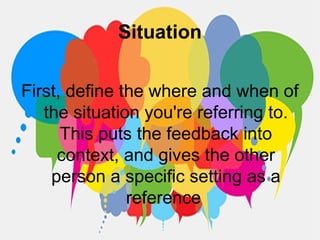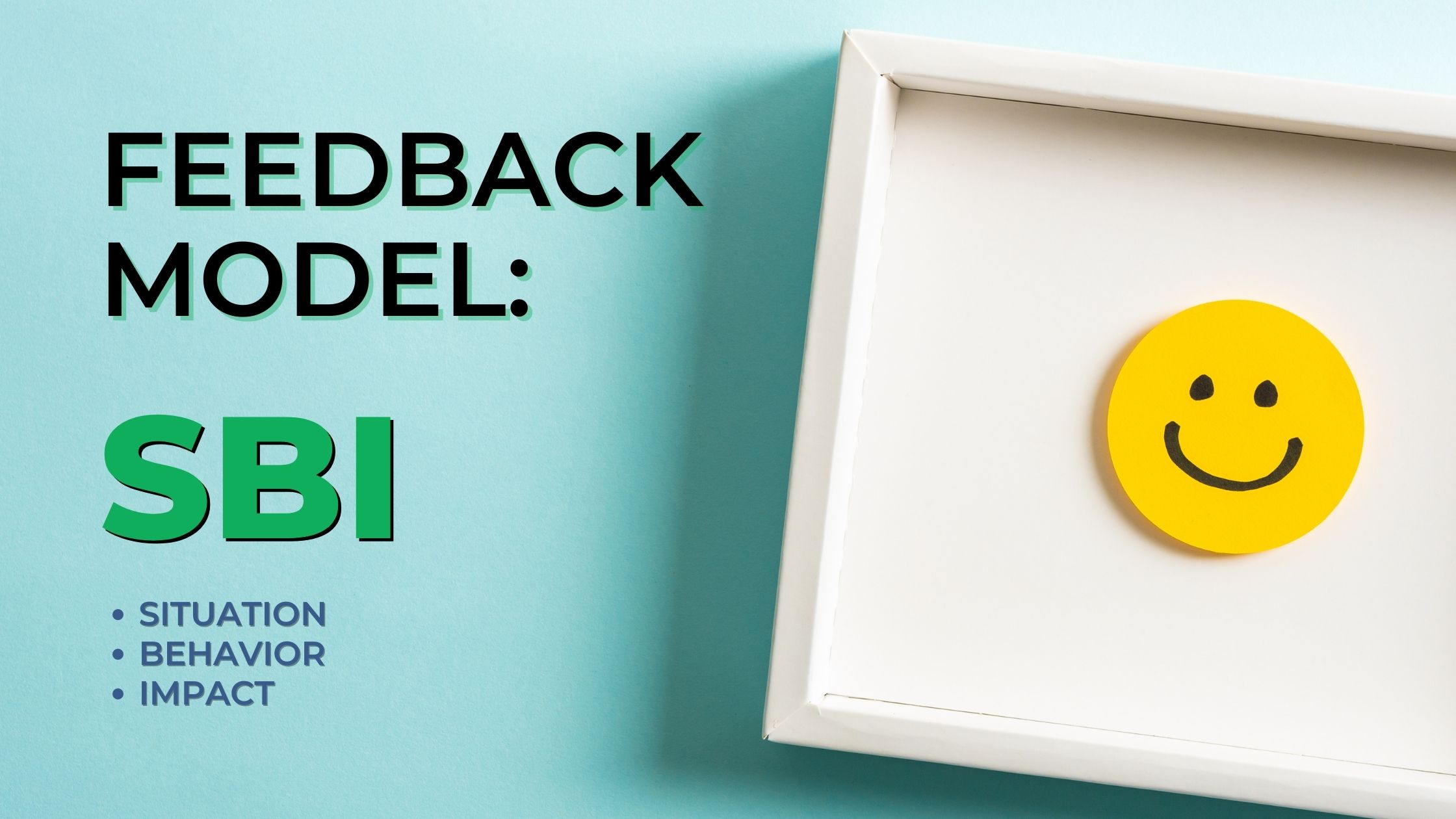Mastering Effective Feedback: Using the SBI Model in Action
Theory
The Situation-Behavior-Impact (SBI) feedback technique is a
structured approach to providing feedback. It aims to make feedback more
specific, objective, and actionable by focusing on three key elements: the
situation in which the behavior occurred, the behavior itself, and the impact
or consequences of that behavior. This model was developed to ensure that
feedback is delivered in a way that is constructive, relevant, and effective in
driving behavioral change.
Usage
The Situation-Behavior-Impact (SBI) feedback technique is a
valuable tool widely used in various professional settings, including education
and healthcare, to provide effective feedback. This technique involves
structuring feedback into three key components: the situation, the observed
behavior, and the impact of that behavior. By providing specific and objective
feedback using the SBI model, the focus is shifted from personal attributes to
observable actions and their consequences.
Academic literature supports the usage of the SBI feedback technique as an effective approach for enhancing performance and promoting growth. For instance, research by Kluger and DeNisi (1996) highlights the importance of specific feedback in improving task performance, emphasizing that feedback should address observable behaviors rather than making generalizations about the individual. Another study by Hattie and Timperley (2007) emphasizes the significance of timely and actionable feedback that focuses on specific aspects of performance. By incorporating the SBI model, educators and trainers can provide feedback that is clear, constructive, and impactful, ultimately facilitating learning and development in the individuals they are working with.
How to Use SBI Feedback Technique
Describe the Situation:
Start by describing the specific situation or context in which the behavior took place. Be clear and concise in explaining the circumstances surrounding the behavior. This helps provide a clear frame of reference for the feedback recipient.
For example:
Situation: During a team meeting, a colleague consistently
arrives late, causing delays in starting discussions and impacting the
productivity of the group.
By describing the situation, you provide a clear context for
the feedback recipient to understand the specific circumstances surrounding
their behavior. This sets the stage for the feedback conversation and helps the
individual recognize the relevance and impact of their actions.
Discuss the Behavior:
For example:
Behavior: Your colleague arrives 10-15 minutes late to team
meetings consistently over the past month without prior notification or valid
reason, causing disruptions and delays in starting discussions.
By identifying the specific behavior, you focus on the
specific actions or patterns of behavior that are of concern. It's important to
provide objective and observable information about the behavior rather than
making assumptions or generalizations. This helps the feedback recipient
understand the specific actions they need to address or modify.
Explain the Impact:
Share the impact or consequences of the behavior on yourself, others, or the overall situation. Be specific about how the behavior influenced the outcome, the team dynamics, or the learning environment. Describe both the positive and negative effects, emphasizing the importance of the behavior's impact.
For example:
Impact: The consistent lateness to team meetings has
resulted in delayed start times, disrupting the flow of discussions and causing
frustration among team members. It has also led to reduced productivity as
valuable meeting time is wasted waiting for your presence. The team's ability
to collaborate effectively and make timely decisions is compromised due to the
disruptions caused by the late arrivals.
Offer Suggestions for Improvement:
After discussing the impact, provide constructive suggestions for improvement. Offer specific recommendations or strategies that can help the individual modify their behavior or achieve a more desirable outcome. Focus on actionable steps that can be taken to enhance their performance or address any areas of concern.
For example:
Suggestions for Improvement: To address this issue, it would
be beneficial to make a conscious effort to prioritize punctuality and arrive
on time for team meetings. Consider setting reminders or adjusting your
schedule to ensure you can join the meetings promptly. If unforeseen
circumstances arise, please communicate in advance and provide an update on
your expected arrival time. Additionally, actively participating in discussions
and contributing to the team's goals will help maximize the productivity and
effectiveness of the meetings.
By offering suggestions for improvement, you provide
actionable recommendations or strategies that can help the feedback recipient
modify their behavior or achieve a more desirable outcome. These suggestions
aim to support their growth, facilitate positive change, and address any areas
of concern identified during the feedback process.
More Examples
Example 1:
Situation: During a clinical rotation, a nursing student
encountered a challenging patient situation where the patient was anxious and
uncooperative.
Behavior: The student responded by maintaining a calm
demeanor, actively listening to the patient's concerns, and employing
therapeutic communication techniques to establish trust.
Impact: The patient's anxiety decreased, they became more
cooperative, and they expressed appreciation for the student's approach,
leading to a smoother patient care experience.
Suggestion: Continue utilizing effective communication
techniques to engage and address the concerns of anxious or uncooperative
patients. It helps in building rapport, reducing anxiety, and promoting
patient-centered care.
Example 2:
Situation: During a medical simulation, a resident performed
a procedure but failed to adhere to proper infection control practices.
Behavior: The resident did not sanitize their hands before
the procedure and did not use sterile gloves, potentially exposing the patient
to infection risks.
Impact: The breach in infection control compromised patient
safety, increased the risk of healthcare-associated infections, and undermined
the trust and confidence of the patient.
Suggestion: Always prioritize infection control protocols,
including hand hygiene and proper use of personal protective equipment.
Consistently following these practices minimizes the risk of infection
transmission and ensures patient safety.
These examples demonstrate how the SBI feedback technique can be utilized in training contexts to provide targeted feedback on specific behaviors, address their impact on outcomes, and offer actionable suggestions for improvement. The technique helps learners understand the consequences of their actions, reflect on their performance, and make necessary adjustments to enhance their skills and patient outcome.
The SBI feedback technique provides a structured framework for delivering feedback that is specific, objective, and actionable. By focusing on the situation, behavior, and impact, feedback givers can provide meaningful insights that enable individuals to understand the consequences of their actions and make improvements accordingly.
As a bonus, you may refer to this bite-sized video on the SBI technique.







Comments
Post a Comment